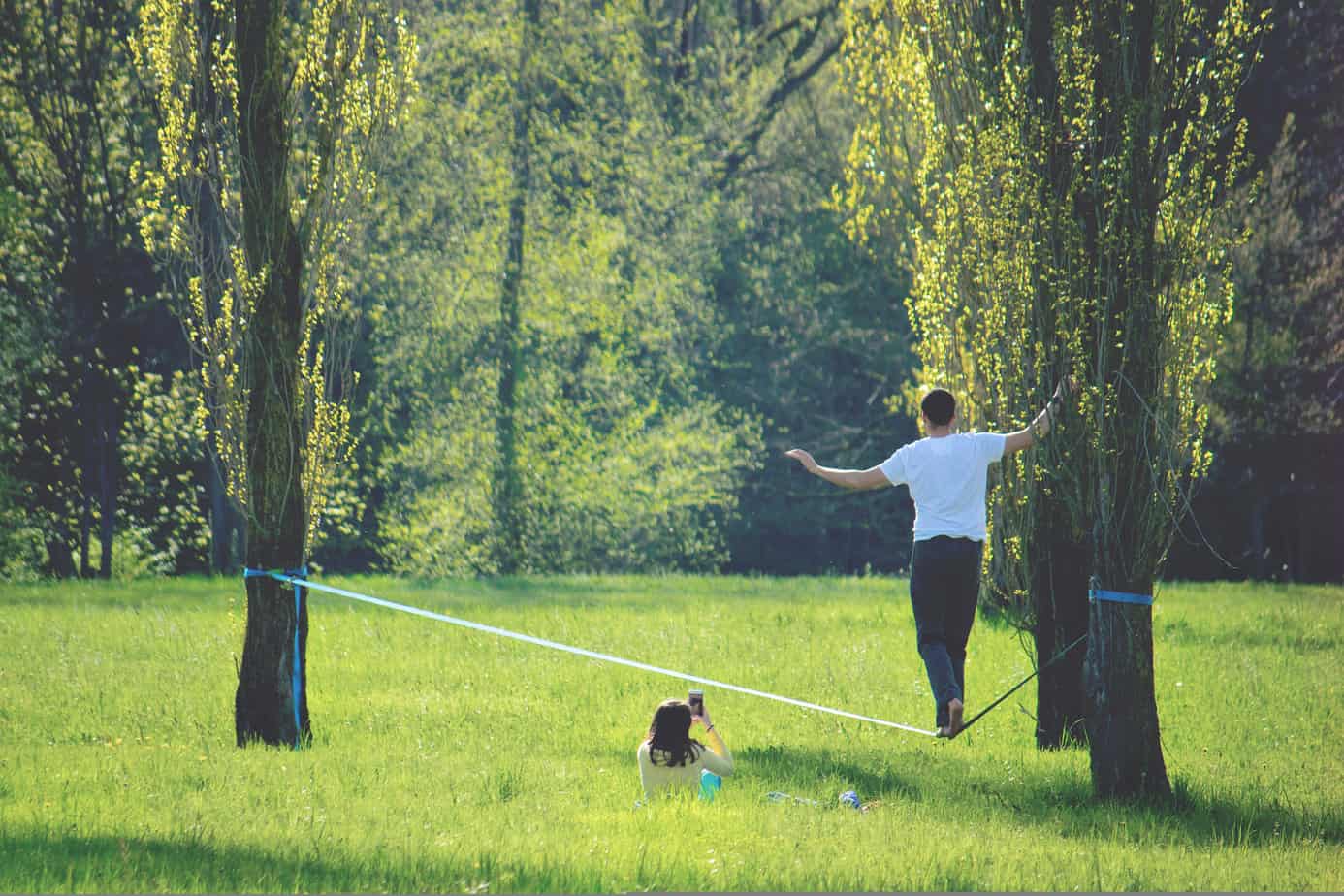Trees that are being used to set up a beginner’s slackline should be at least 15′ (4.5m) apart, with the slackline spanning the distance between them. This distance is necessary to ensure that there is enough tension in the line and to allow for proper rigging and setup of the line.
Keep in mind that this distance is a minimum, and if you are setting up a longer slackline, or one with a higher tension, you may need to find more space between the trees that you use. Additionally, it is important to make sure the trees are healthy and sturdy, and that the area around the trees is clear of obstacles.
The longer the slackline, the more sway and less stability you have which makes slacklining more difficult. As you progress, you can set up longer slacklines to increase the challenge and skills required.
You can easily find slacklines for beginners in the 25′ – 30′ (8m – 9m) range and longer ones up to 100′ (30m) in length. Then you get into longlines which are generally 130′ (40m) and up and can even consider longer lines for advanced use.
What Criteria Makes A Tree Suitable For Attaching A Slackline To?
When selecting trees to use as anchor points for a slackline, there are a few criteria that should be considered to ensure that the trees are suitable:
- Tree Health: The tree should be healthy, with no signs of rot, disease, or structural damage. Dead or dying trees should not be used as anchor points.
- Tree Size: The tree should be at least 12″ (30 cm) in diameter at breast height (DBH) for smaller slackline and 20″ (50cm) for larger slackline. Larger trees are generally more stable and are less likely to move or be damaged when the slackline is rigged to them.
- Tree Location: The tree should be located in an open area, free of obstacles and other trees that could interfere with the slackline or the rigger. The location should be relatively level and the ground should be firm and stable.
- Distance between trees: Trees should be at least 15′ (4.5 m) apart, with the slackline spanning the distance between them. As explained before this distance is a minimum, and if you are setting up a longer slackline, or one with a higher tension, you may need to space the trees farther apart.
- Permission: Make sure you have permission from the landowner or manager to set up your slackline if the trees are not on your own property. Increasingly, slacklining is either regulated on certain properties or outright disallowed.
Also, when setting up the slackline, it’s important to be mindful of the tree’s ecosystem and avoid harming the tree in any way.
Additionally, when rigging the slackline, use padded straps or other tree protection to protect the tree’s bark, and remove the slackline after use.
Where Can I Set Up My Slackline If I Have No Suitable Trees?
If you do not have suitable trees to set up a slackline, there are a few other options you can consider:
- Slackline poles: You can purchase specialized poles or posts specifically designed for slacklining. These poles can be set up on a flat surface, such as a field or parking lot, and are anchored into the ground for stability.
- Portable rigging: There are portable rigging systems available that can be used to set up a slackline between two points, such as two cars or other anchor points, even if they are not trees.
- Indoor Slacklining: You can purchase an indoor slacklining kit to set up inside your home. You can also set up a slackline indoors at a gym or rock climbing gym that offer this option. This can be a great way to practice and improve your skills in inclement weather, during winter or when you don’t have access to suitable outdoor space.
- Playground Equipment: Some playgrounds have a monkey bar or similar equipment that can be used to set up a slackline between. This can be a good option if the playground is less busy ans assuming it’s allowed.
It’s important to keep in mind that when setting up a slackline, it is important to use a sturdy, stable anchor point and to rig the line properly to ensure that it is safe to use.
Additionally, it is important to use appropriate safety equipment, such as a helmet and protective pads, when using a slackline, no matter where it is set up.
Looking for places to slackline? Start here to find a location near you.
Recent Posts
Slacklining is a challenging activity that involves walking, balancing, and performing tricks on a flat piece of webbing stretched between two anchor points. It has become increasingly popular in...
Slacklining is a fun and challenging way to improve your balance, core strength, and overall fitness. Whether you're new to slacklining or a seasoned pro, incorporating a slackline workout routine...


